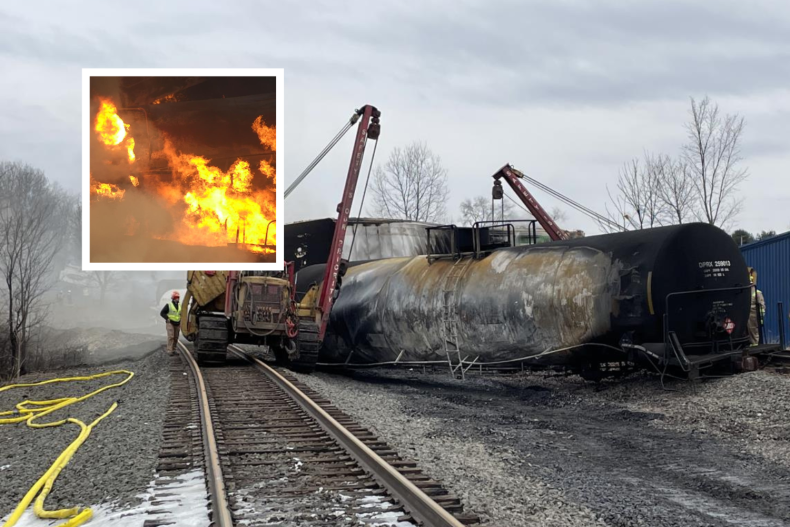Toxic Chemicals From Ohio Train Derailment: Extended Building Contamination

Table of Contents
Types of Toxic Chemicals and Their Impact on Buildings
The derailment released a cocktail of hazardous materials, most notably vinyl chloride, butyl acrylate, and ethylhexyl acrylate. These chemicals possess distinct properties that significantly impact building materials and the health of occupants.
-
Vinyl Chloride: A known carcinogen, vinyl chloride is a colorless gas that readily penetrates porous materials like wood, drywall, and insulation. Its presence can lead to material degradation, discoloration, and even structural weakening over time. Long-term exposure is linked to serious health problems.
-
Butyl Acrylate & Ethylhexyl Acrylate: These acrylates are volatile organic compounds (VOCs) that can also infiltrate building materials. While less acutely toxic than vinyl chloride, prolonged exposure can cause respiratory irritation, headaches, and other health issues. They can also contribute to indoor air quality problems.
-
Impact on Building Materials: The chemical composition of these substances significantly affects different building materials. For instance, vinyl chloride's corrosive properties can damage metal pipes and fixtures, while acrylates can leach into water supplies within buildings, contaminating drinking water sources. The long-term effects on building materials include weakening, discoloration, and potential structural damage, requiring costly repairs or even demolition in severe cases. The lifespan of affected buildings may be dramatically reduced.
Assessing and Monitoring Building Contamination
Accurately assessing the extent of building contamination after the Ohio train derailment requires a multi-pronged approach involving comprehensive environmental testing.
-
Environmental Testing: This crucial step involves testing air, water, and soil samples both inside and around buildings. Air quality testing detects airborne chemicals, while water testing checks for contamination in plumbing systems and wells. Soil testing assesses the extent of ground contamination, which can impact building foundations and potentially leach into water supplies.
-
Professional Expertise: It’s imperative to utilize certified laboratories and experienced environmental professionals for accurate testing and result interpretation. These professionals possess the expertise and equipment necessary for reliable analysis of the complex chemical mixture released during the derailment.
-
Building Inspection: A thorough visual inspection of the building is essential to identify potential entry points for contaminants and observe any signs of damage or discoloration consistent with chemical exposure. This assessment should be conducted by experienced professionals who understand the specific risks associated with the released chemicals.
-
Regulatory Oversight: Regulatory agencies play a vital role in overseeing testing and remediation efforts, ensuring compliance with safety standards and protecting public health. They provide guidelines and enforce regulations related to environmental cleanup and hazardous waste disposal.
-
Interpreting Test Results: Understanding the test results is critical. Professionals will identify areas of significant contamination and determine the most appropriate remediation strategies based on the levels of detected chemicals.
Remediation and Cleanup Strategies for Contaminated Buildings
Remediating contaminated buildings after a major chemical release like the Ohio train derailment requires specialized strategies.
-
Decontamination Techniques: These include various methods such as air purification using HEPA filters and activated carbon, water filtration systems to remove contaminants from drinking water sources, and the complete removal and disposal of severely contaminated building materials.
-
Hazardous Waste Disposal: Proper disposal of contaminated materials is paramount. This involves following strict regulatory guidelines for handling and transporting hazardous waste to licensed facilities.
-
Restoring Building Materials: After decontamination, restoring affected building materials may be necessary. This can involve repairs, replacement, or specialized treatments to mitigate long-term damage.
-
Safety Protocols: Strict safety protocols are essential throughout the entire remediation process to protect workers and residents. This includes using appropriate personal protective equipment (PPE) and adhering to safety guidelines established by regulatory agencies.
-
Cost Implications: Building remediation following a chemical release is inherently costly. Factors influencing the cost include the extent of contamination, the size of the building, the necessary remediation techniques, and disposal fees for hazardous waste.
Long-Term Health Risks Associated with Building Contamination
Exposure to the toxic chemicals released during the Ohio train derailment presents significant long-term health risks.
-
Health Effects: Vinyl chloride exposure is linked to an increased risk of various cancers, including liver cancer. Exposure to acrylates can cause respiratory problems, skin irritation, and neurological effects. Long-term exposure can lead to chronic health issues.
-
Chemical-Specific Risks: The specific health risks associated with each chemical are well-documented and should be carefully considered during assessment and remediation.
-
Monitoring Resident Health: Ongoing monitoring of residents’ health in affected areas is crucial for early detection of any health issues stemming from chemical exposure.
-
Resources and Support: Various resources are available for individuals seeking health information and support. These include local health departments, environmental agencies, and healthcare professionals specializing in toxicology and environmental medicine.
Conclusion
The Ohio train derailment serves as a stark reminder of the devastating and long-lasting consequences of toxic chemical releases. The potential for extended building contamination necessitates thorough testing, appropriate remediation strategies, and ongoing monitoring. Protecting the health and safety of the community requires a proactive approach, including prompt identification of affected buildings and swift implementation of remediation measures.
Understanding the potential for toxic chemicals from the Ohio train derailment to contaminate buildings is essential for protecting public health and the environment. If you suspect your building may be affected, contact a qualified environmental professional immediately for testing and remediation. Don't delay; protecting your community from the lasting impact of this disaster is vital.

Featured Posts
-
 Empate Sin Goles Everton Vina 0 0 Coquimbo Unido Resumen Y Analisis
May 16, 2025
Empate Sin Goles Everton Vina 0 0 Coquimbo Unido Resumen Y Analisis
May 16, 2025 -
 Dodgers Muncy Abandons Torpedo Bat Delivers Crucial Game Tying Hit
May 16, 2025
Dodgers Muncy Abandons Torpedo Bat Delivers Crucial Game Tying Hit
May 16, 2025 -
 Athletic Club De Bilbao Match Reports Player Profiles And More On Vavel Usa
May 16, 2025
Athletic Club De Bilbao Match Reports Player Profiles And More On Vavel Usa
May 16, 2025 -
 Almeria Eldense Resumen Y Goles La Liga Hyper Motion
May 16, 2025
Almeria Eldense Resumen Y Goles La Liga Hyper Motion
May 16, 2025 -
 Victoria De Portugal Ante Belgica 0 1 Resumen Completo
May 16, 2025
Victoria De Portugal Ante Belgica 0 1 Resumen Completo
May 16, 2025
